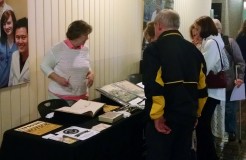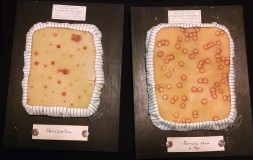Recent outbreaks of Ebola, Lyme disease, and Avian Flu have captured headlines, though it was not too long ago that polio and smallpox posed serious threats to human health.
So, it was no surprise that infectious diseases was the theme of the latest Mini Medical School, which featured Wangensteen Historical Library’s Lois Hendrickson as a guest lecturer.
“We were asked to bring artifacts, archives, and rare books around the topic of infectious disease,” said Hendrickson, Curator of the Wangensteen Historical Library. “We selected primary resources that showed major milestones in the treatment of diseases such as smallpox, diphtheria, and measles.”
About Mini Medical School
Each semester, the University of Minnesota Academic Health Center presents the five-week-long Mini Medical School for community members wanting a glimpse of life as a health sciences student.
The “students” study the latest in health research, therapies, and medical devices on a given topic. But they learn about historical contributions to the advancement of health, also, thanks to Hendrickson and the Wangensteen Historical Library.
Medical artifacts and ephemera
– Christopher Herzberg
Hendrickson, making her third Mini Medical School appearance, presented medical artifacts and ephemera from an exhibit that included a diphtheria intubation kit (ca. 1890), quarantine signs (ca. 1930), a thumb lancet used for bloodletting (nd), and Japanese public health broadsides related to a measles outbreak (1862).
Several books were also selected, including a 1941 book by Sister Kenny, a pioneer on polio treatment, and a 1878 book by Edward Jenner, a pioneer of the smallpox vaccination.
“Jenner’s ideas were considered too revolutionary for the time,” said Hendrickson. “Undaunted by his critics, Jenner continued his experiments on children – including his 11-month-old son. The results of his work were finally published in 1798, where Jenner coined the word vaccine from the Latin vacca for cow.”
Perhaps the most interesting item on display was the recently cataloged wax moulages (molds) depicting infectious diseases. The molds were designed by Theodor Henning (1897-1946), who was trained by his father while studying at the Vienna Art Academy.
“The wax molds were a popular and important tool in the development of pathologic anatomy,” said Hendrickson. “They were particularly important with regard to dermatology, which emphasizes observation by the clinician.”
Telling a story
The exhibit, presented by Hendrickson and her colleague, Christopher Herzberg, was extremely popular with Mini Medical School participants.
“The tables were packed for the entire hour we presented,” said Herzberg. “While we shared the items from the Wangensteen Historical Library collection, we had the best conversations with people visiting our display.”
One person remembered that a quarantine sign was nailed to his house when he was a young child while his family had rubella.
Others learned that the D in the DTaP vaccine stands for Diphtheria. This bacterial infection affecting the mucous membranes of the nose and throat was once a major cause of illness and death among children until its vaccine was developed in the 1920s. Today, the word Diphtheria is almost forgotten, thanks to the widespread vaccination against the disease.






